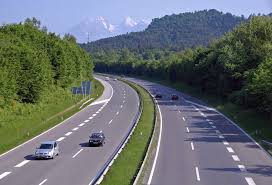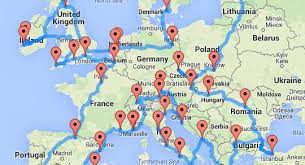A European road trip is a dream for many travelers, offering the freedom to explore diverse landscapes, cultures, and historic sites at your own pace. Whether you’re interested in winding coastal roads, charming medieval villages, or bustling city centers, Europe provides the perfect backdrop for an unforgettable journey. But planning such a road trip can be daunting without the right guidance. This ultimate guide will break down everything you need to know to plan the road trip of your dreams in Europe. From choosing your route to finding accommodations and understanding the logistics, we’ll cover it all.
How to Choose the Best Route for Your European Road Trip
Choosing the right route is the foundation of your European road trip. Europe is vast, with endless possibilities for exploration. Whether you’re interested in hitting major tourist destinations or taking the scenic backroads, your route should reflect your interests and the time you have available.
One of the most popular road trip routes is the classic drive through France, Belgium, Germany, and Switzerland, where you’ll encounter medieval castles, vineyards, and stunning mountain views. Another option is the Mediterranean route, which takes you through Spain, Italy, and Greece, offering breathtaking coastal drives and iconic historic landmarks. If you’re after a more off-the-beaten-path experience, consider the Eastern European route, which allows you to discover hidden gems in countries like Poland, Hungary, and Romania.
When is the Best Time to Go on a Europe Road Trip?
Timing is essential when planning a Europe road trip. The best time to hit the road in Europe depends on the experience you’re looking for and the weather you prefer. Summer, from June to August, is the most popular period, offering warm weather and longer days, but also higher crowds and more expensive accommodation options.
If you prefer a quieter experience, late spring (May to early June) or early autumn (September to October) is an ideal time to travel. During these months, you’ll enjoy pleasant weather and fewer tourists, making it easier to explore hidden gems without the crowds. However, do keep in mind that temperatures in Northern Europe can still be quite chilly in the spring and fall, so pack accordingly.
What to Pack for a European Road Trip
Packing for your European road trip requires a balance between practicality and comfort. You’ll be spending a lot of time in the car, so comfort is key. Consider bringing travel pillows, blankets, and snacks to make long drives more enjoyable. It’s also important to have a travel bag that’s easy to access while on the road for any essentials you might need, such as your phone, water, or sunglasses.
Beyond the basics, there are a few other things you’ll need to pack for your European adventure. A good travel guidebook can help you find hidden gems along the way, and a paper map (or offline maps on your phone) can come in handy in areas with limited Wi-Fi. Don’t forget to pack a car charger, as you’ll likely use your phone for navigation throughout the trip.
How to Rent a Car for Your Europe Road Trip
Renting a car for your European road trip is relatively straightforward, but there are some important things to keep in mind. First, make sure you meet the age requirements, which vary by country but are typically around 21 years old. Some countries may have additional age fees for drivers under 25.
You’ll also want to check the driving laws in each country you plan to visit, as rules can differ across Europe. For example, some countries require drivers to carry a safety kit, including items like reflective vests and warning triangles, while others do not. If you’re planning to drive in cities, it’s worth checking if your rental car has low emissions or if you’ll need a special permit to enter certain areas.
Driving in Europe: Things You Should Know

Driving in Europe can be an enjoyable experience, but it’s important to familiarize yourself with some key driving rules. In most European countries, driving is on the right-hand side of the road, with the exception of the United Kingdom, Ireland, and a few other places. Speed limits, road signs, and regulations may vary between countries, so it’s a good idea to familiarize yourself with these before hitting the road.
Tolls are common in many European countries, especially on highways, so be prepared to pay. A good rule of thumb is to always carry a mix of cash and credit cards to cover toll costs, which can sometimes be cash-only in more rural areas. Parking in cities can be challenging, so consider looking for hotels with parking included or staying slightly outside the main city areas to save time and money.
Where to Stay During Your Europe Road Trip
Accommodation is a crucial part of your European road trip planning. Fortunately, Europe offers a wide range of options to suit all budgets and preferences. From luxury hotels to cozy guesthouses and from countryside villas to rustic campsites, there’s something for every traveler.
If you’re traveling on a budget, consider booking hostels or Airbnb rentals, which can often be cheaper than hotels and provide a more local experience. If you’re after a more comfortable experience, look into booking stays in boutique hotels, which often offer great amenities and a personalized touch. For those looking for a more adventurous stay, there are many campsites and glamping options in beautiful natural locations throughout Europe.
How to Plan Your European Road Trip Budget
The cost of a European road trip can vary greatly depending on the route, duration, and accommodation choices. To keep costs manageable, start by creating a rough budget that includes all essential expenses, such as car rental, fuel, accommodation, food, and any additional costs like sightseeing and activities.
Car rental costs will depend on the type of car you choose and the duration of your trip. In addition to the rental price, you’ll need to budget for fuel, which can add up quickly depending on how much driving you plan to do. It’s also important to factor in road tolls and parking fees, which can vary depending on the country and location. While food costs in Europe can be reasonable, dining out at tourist hotspots can quickly become expensive, so it’s often cheaper to eat at local markets or roadside cafés.
Top Destinations for Your European Road Trip
Europe is home to many iconic destinations that are perfect for a road trip. Some of the most popular destinations include:
The Amalfi Coast, Italy— Famous for its stunning cliffs, colorful towns, and Mediterranean charm, the Amalfi Coast is a must-see for any European road trip.
The French Riviera—Drive along the coast and visit glamorous cities like Nice, Cannes, and Monaco, where you can enjoy Mediterranean views and exquisite cuisine.
The Swiss Alps—If you love mountain landscapes, Switzerland’s Alps offer spectacular views, charming villages, and thrilling outdoor activities.
Scotland’s Highlands— Known for its rugged terrain, ancient castles, and picturesque lochs, Scotland is ideal for a road trip full of natural beauty and history.
The Balkans— A less-traveled route, the Balkans offer incredible beaches, medieval towns, and diverse landscapes. Countries like Croatia, Montenegro, and Slovenia are perfect for those looking for something unique.
Essential Tips for a Smooth Europe Road Trip Experience
While planning your European road trip, keep these tips in mind to ensure a smooth journey:
Stay flexible: While it’s important to plan your route and accommodations, be open to making spontaneous stops along the way to explore hidden gems or take photos.
Use technology: Apps like Google Maps, Waze, and TripAdvisor can help with navigation, finding attractions, and reading reviews of local businesses.
Learn basic phrases: While many people in Europe speak English, it’s helpful to learn a few basic phrases in the local language, especially in more rural areas.
Book in advance: For popular destinations, particularly in peak seasons, it’s a good idea to book accommodations in advance to secure the best rates.
Conclusion: Start Your European Road Trip Today
A European road trip offers the ultimate freedom to explore the continent on your own terms. By carefully planning your route, budget, and accommodations, and being prepared for the driving challenges, you’ll create memories that last a lifetime. Europe’s rich history, diverse landscapes, and welcoming culture make it the perfect destination for a road trip, so pack your bags, fuel up the car, and get ready for the adventure of a lifetime.


